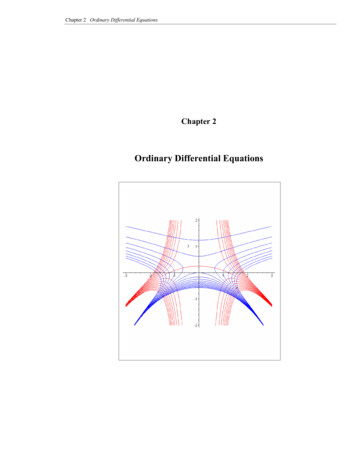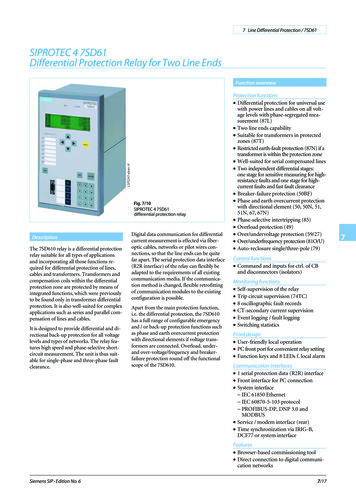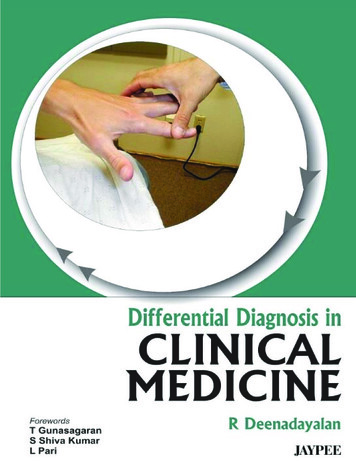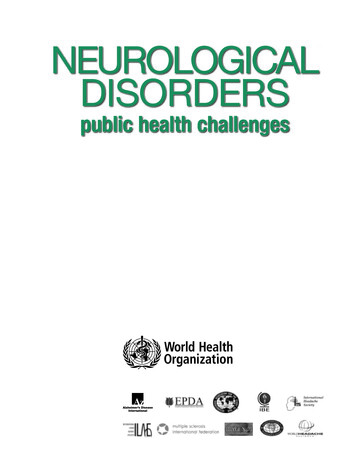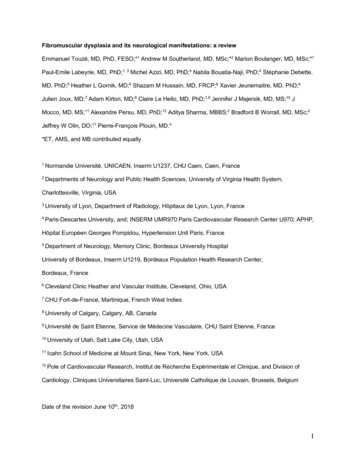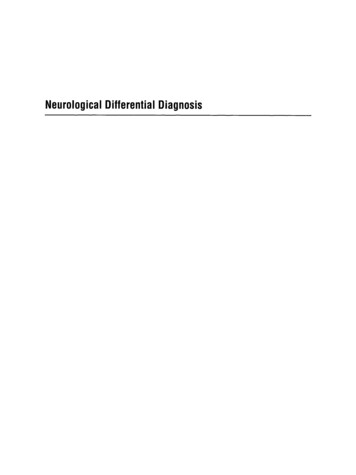
Transcription
Neurological Differential Diagnosis
Springer-Verlag London Ltd.
JOHN PATTENNeurologicalDifferentialDiagnosis2nd EditionSpringer
John Philip Patten, BSe, MB, BS, FRCPConsultant Neurologist, King Edward VII HospitalMidhurst, Sussex GU29 OBl, UKFormerly: Consultant Neurologist to South West ThamesRegional Health Authority; Visiting Assistant Professor,University of Texas Medical Branch, Galveston; Resident MedicalOfficer, National Hospital for Nervous Diseases, Queen Square, LendonBritish Library Cataloguing in Publication DataPatten, JohnNeurological DifferentialDiagnosis.2 Rev. edI. Title616.80475ISBN 978-3-642-63813-8ISBN 978-3-642-58981-2 (eBook)DOI 10.1007/978-3-642-58981-2Library 01 Congress Cataloging-in-Publication DataPatten, John, 1935Neurological differential diagnosis/John Patten. - 2nd ed.p.cm.Includes bibliographical references and index.ISBN 978-3-642-63813-81. Nervous system - Diseases - Diagnosis. 2. Diagnosis, Differential. I. Title.[DNLM: 1. Nervous System Diseases - diagnosis. WL 141 P31Sn 1995]RC348.P371995616.8'0475 - dc20ONLMIOLCfor Library of Congress95-14336Apart Irom any fair dealing for the purposes of research or private study, or criticism or review, as permittedunder the Copyright, Designs and Patents Act 1988, this publication may only be reproduced, stored ortransmitted, in any form or by any means, with the prior permission in writing of the publishers, or in thecase of reprographic reproduction, in accordance with the terms of licences issued by the Copyright LicensingAgency. Enquiries conceming reproduction outside those terms should be senf 10 the publishers. Springer-Verlag Landon 1996Originally published by Springer-Verlag Berlin Heidelberg New York in 1996Softcover reprint of the hardcover 2nd edition 1996Reprinted with corrections, 1996,1998The use of registered names, trademarks, etc. in this publication daes not imply, even in lhe absence of aspecific statement, thai such names are exempt from the relevant laws and regulations and therefore free forgeneral use.Product liability: The publisher can give no guarantee for information about drug dosage and applicationthereol contained in Ihis book. In every individual case the respectlve user must check its accuracy byconsulting other pharmaceuticalliterature.Typeset by EXPO Holdings, Malaysia28/3830-5432 Printed on acid-free paper
To my patients, whose courage, suffering and trusthave served as a constant source of inspiration.To my family past and present, whose love and supporthave made everything possible.
Preface to the First EditionThe majority of doctors are ill at ease when confronted by a patient with a neurological problem.Candidates for qualifying examinations and higher diplomas dread that they will be allocated aneurological 'long case'.This is a serious reflection on the adequacy of training in neurology. It is still possible in somemedical schools for a student to go through the entire clinical course without an attachment to theneurological unit. Increasing competition for teaching time has led to the situation where in most USmedical schools, and at least one new medical school in the UK, a two-week clinical attachment tothe neurology service is considered adequate. Those fortunate enough to attend a postgraduatecourse find a minimum of 3 months' intensive training is necessary before any confidence in tacklinga neurological problem is achieved.Unfortunately, neurological textbooks seldom seem to recognize the intensely practical nature ofthe subject. There are many short texts that achieve brevity by the exclusion of explanatory material;these are difficult to read and digest. At the opposite extreme are the neurological compendia, oftenunbalanced by excessive coverage of rare diseases and all based on the assumption that patientsannounce on arrival that they have a demyelinating, heredofamilial, neoplastic etc. disorder. Thesetexts are useful only to those who already have a good working knowledge of neurological diseases.Patients present with symptoms that need careful evaluation before physical examinations whichin turn should be firmly based on the diagnostic possibilities suggested by the history.Understanding neurological symptoms and signs requires a good knowledge of the gross anatomyof the nervous system, its blood supply and supporting tissues; and yet an almost universal featureof neurological texts is the paucity of instructive diagrams. Most students readily admit that this is aninsoluble problem, as their poorly remembered neurological anatomy is often both inadequate andinappropriate to the clinical situation.The present text is a personal approach to this complex and fascinating subject, and basicallyreflects the way the author coped with this difficulty. The subject matter is dealt with in two ways:1. Symptomatic, regional anatomical basis for those areas where local anatomy determinessymptoms and signs, allowing what might otherwise be regarded as 'small print' anatomy to beunderstood and appreciated;2. Full discussion of the historical diagnostic clues in those conditions that are diagnosed almostexclusively on symptoms such as headache, face pain and loss of consciousness.Throughout, an attempt has been made to preserve the 'common things are common' approachwhich is widely rumoured to be the secret of passing examinations, and is also the basis of goodclinical practice. Rare disorders are discussed briefly, but it is important that beginners realize thatrare diseases are usually diagnosed when it becomes apparent that the disorder does not fit intoany of the common clinical pictures. The first aim therefore should be to gain a very good grasp ofthe common disorders rather than attempting to learn long lists of very rare diseases.The text is profusely illustrated, and although anatomical accuracy has been preserved, artisticlicence has been taken whenever necessary to illustrate an important point. Each diagram is drawnfrom a special angle of view that enables the reader to visualize the area under discussion in situ inthe patient. It is easy to construct a 'diagram' so remote from actual anatomy that it becomesincomprehensible. It is hoped that this problem has been avoided.
viiiPreface to the First EditionNeurological terms are defined whenever they occur and neurological 'jargon' is explained,although the beginner is well advised to keep to factual statements until he is very sure of himself.As an example of the incorrect use of jargon the following is abstracted from a report by a physician.The patient actually had a left sixth nerve palsy and a mild hemiparesis due to cerebal metastases:He has the spastic dystonic gait of the multiple sclerotic. Also he has a third nerve paraplegia withocular movements to the left and with nystagmus. He has cogwheel rigidity of the upper extremities and an absence of patel/ar reflexes. His speech is beginning to slur and there is the maskfacies of the multiple sclerotic . I do not believe . further studies to be necessary as the clinicalsigns are aI/ too obvious!Specific references are not given; this book is intended for the novice who wishes to develop a'feel' for the subject and in the author's opinion references are unnecessary. This is not intended toindicate that the writer claims originality for all the information provided. The knowledge contained inthis text is a distillate of wisdom gained from many teachers and, indeed, generations of teachers,who have passed on their own observations. The personal part of this text is the attempt to organizethis information around the anatomy of the nervous system to reinforce this knowledge and makethe subject less intimidating to the beginner. In particular I would like to acknowledge my debt to myfirst teacher, Dr Swithin Meadows, who aroused my enthusiasm for the subject and then inspired meto attempt to emulate his skill as a clinical neurologist.I am also indebted to many undergraduate students at Westminster Medical School, UniversityCollege Hospital and the University of Texas Medical Branch, and postgraduates at the NationalHospital for Nervous Diseases, whose questions, suggestions and enthusiasm originallyencouraged me to bring this approach to a wider audience.Dr John R. Calverley, Associate Professor of Neurology in the University of Texas Medical Branchat Galveston, provided enormous encouragement in the early development of this project andallowed me to try the format on several generations of postgraduate students in his department.I would like to express my thanks to him and his colleagues for making my stay so instructive andenjoyable. Dr M. J. Harrison read the original manuscript and made many useful suggestions whichhave been incorporated into the text. I am very grateful for his help and encouragement.I would like to thank my wife and family for their continued support during the years this text hasbeen in preparation, and Miss Gillian Taylor for typing the often illegible manuscript.John Patten(1975)
Preface to the Second EditionSince this book was first published 19 years ago, I have often been asked what prompted me towrite it and who had done the illustrations. The answers to these questions are intimately related inreverse order. The book actually evolved around the collection of illustrations that I had drawn andconstantly revised to improve my own knowledge of neuroanatomy, ever since my preclinical training began in 1954. My art master at school was upset that I would not transfer to art college at theage of 14 and my father was upset that I resisted his attempts to persuade me to study architecture,but I was allowed to study art as an extra subject until my A-level examinations.I eventually realized that my attempts were successfully clarifying the often incomprehensibleillustrations in most neurology textbooks of the time. These usually consisted of blobs and lines, withlittle or no structural form to relate them to the brain, spinal cord or any position inside the person.The book therefore developed around some of these key illustrations. They started to take finalshape while I was teaching at the University of Texas Medical Branch in Galveston, between 1968and 1971. I had the opportunity to run an evening course in advanced neurology and each 2-hourlecture was based on a single hand-out diagram of the area under consideration, and this provE3dextremely popular and a sound basis for discussion of differential diagnosis.The then available textbooks were very heavy on ponderous prose and very light on practicaldiagnosis and management, and almost bereft of illustrations to both lighten the text and provideclarification. The main motivation, therefore, was to write the textbook that I wished had been available to me when I started in neurology. The temerity to attempt to write such a book at a relativEllyearly stage in my career came from the feeling that it was essential to do this before I became tooremote from the initial learning process and had forgotten the problems that had caused me themost difficulty. I was only too aware of this because I was so often 'fobbed off' by my own teacherswhen I asked for an explanation of some unusual feature in a case, and was asked to accept'because it happens' as an adequate explanation. I realized that they had either forgotten or hadnever understood the underlying anatomical basis of some of the more bizarre but well-knownpeculiarities of the behaviour of neurological disease processes.The actual format of the book, which was unique at that time, was undoubtedly influenced bythree widely differing textbooks that had made a dramatic impression on me. The first was Biologicaldrawings by Maud Jepson (1938), an ancillary textbook for advanced-level zoology and botanystudies which first brought to my attention just how much information can be conveyed from a carefully constructed illustration, with detailed annotations rather than labels. The second was Bedsidediagnosis by Charles Seward, which was the first short textbook in any subject that made it clearthat thumbnail sketches of specific illnesses could convey vast amounts of information, withoutbecoming telegraphic meaningless sentences. Finally, as a house physician, the only textbook onmy first ward was a copy of Frank Walsh's original textbook Clinical neuro-ophthalmology (1947).This was a massive tome where the text was both lightened and enhanced by little case reports ofvariable length that not only put immediate meat on the skeleton of information under discussion butalso seemed to leave it indelibly printed on the memory, in a way that I had not encountered previously. Any merit the present book has undoubtedly owes a lot to these formative influences.Neuroanatomical illustration requires an admixture of representational artwork, line illustrationsand modified technical drawing techniques, including exploded sections of the diagram to make
xPreface to the Second Editionspecial points. Drawings of all these types are to be found in the original volume. In this latestversion, my son Graham, who actually modelled for the childhood Duchenne dystrophy in the firstedition and is now a graduate in scientific illustration and head of design and advanced applicationsat Virtuality PLC, has assisted me and the overall improvement in the quality of illustrations oweseverything to his advice and skill and his own redrawing of several of my originals. I hope that if athird edition becomes possible, our joint efforts, perhaps using advanced technology to provide aback-up to the text, may produce an even better result.In this revision very much more time was spent on the text than was originally envisaged, becauseof the total transformation of the speciality in the last 15 years by imaging techniques and neurophysiological advances. When the first edition was completed, CT scanning was in its infancy, visualevoked responses had only just been standardized and the main investigational techniques werestill lumbar puncture, angiography, myelography and air encephalography. All these procedureshave potentially serious drawbacks and are even potentially lethal if incorrectly applied. It becameapparent that a surprising amount of the previous text was concerned with information designed toavoid these complications and facilitate diagnosis on clinical grounds, using minimal investigationsto confirm or refute the diagnosis, with the least risk to the patient. Unfortunately it is also true thatthere are many parts of the world where neurologists still have no access to the full range of moderninvestigational techniques, and even in the developed areas limited access and expense maypreclude their use.The investigational agenda may have altered but the practical importance of making a soundclinically based diagnosis before embarking on investigations remains the same. All the availabletechniques have limitations, and even the final interpretation of the significance of MRI scan findingsoften requires consideration of the clinical features in the case before final resolution. A 'scan firstand think later' philosophy has little to commend it, and yet threatens to take over as both anexpensive, and in many instances ineffectual, method of working. At least 75% of neurologicalpractice does not deal with diseases where there is a simple solution that can be revealed byscanning.There is also the risk of an attitude gaining ground that the 'scans are normal therefore there canbe nothing wrong', and this is an inevitable consequence of practising sloppy, short-cut neurology.For this reason, the main content of this textbook, which is firmly based on detailed analysis ofpatients' symptomatology and the careful search for possibly associated physical findings, shouldnot be the dying gasp of clinical neurology as my generation knew it. I think this information will haveto be learned again if this hardwon knowledge is lost as a result of the neurological consultationbecoming shortened to 5 minutes without examining the patient, the only decision taken being whichpart of the body to scan. This type of approach ignores the fact that at least half the patients referredwill not have a neurological disease, or indeed any disease at all, and these patients in particularcan only be effectively identified by a very detailed analysis of their symptoms and always takemore time than patients with clear-cut and easily identifiable neurological disease.The success of the previous edition was surprising: numerous foreign language versions, multiplereprints, and friendly reviews and kind unsolicited comments from many colleagues, have all been asource of great satisfaction, and its continuing popularity many years after much of the investigational detail was long out of date is reassuring. Unfortunately, for various personal reasons therehas been no possibility of rewriting or updating until recently.Many of the original reviews commented on the quality and value of the simple clinical informationcontained, and this is now expanded and honed as a result of my seeing over 2000 new outpatientsand 400 emergency admissions per annum over the last 20 years. The first 8 years were in a unitwithout neurosurgery on site and without the advantage of CT scanning, which was regarded by theNHS as an expensive luxury, as was MRI scanning, until several years after their establishment asimportant new investigational techniques. Their advent has more than adequately demonstratedthat the hardwon clinical skills of several generations of neurologists are precise and valuable. Thereis much pleasure to be derived from seeing a scan reveal exactly what the clinical picture had suggested. Until scanning became available, important instant management decisions had to be takenpurely on the basis of clinical experience.This new edition is therefore offered in the hope that it will help a new generation of aspiringneurologists to get a head start in the specialty, armed with the clinical core knowledge that willenhance their enjoyment of their work and be of benefit to those who seek their advice.
Preface to the Second EditionxiI would like to put on record my appreciation of the help I have received in my clinical practiiceover the past 20 years, and the advice and encouragement from others during the preparation ofthis volume. I have been very fortunate in having Dr Tony Broadbridge as my neuroradiologistduring most of that period when we had to continue practising 20th century neurology without theadvantage of CT scanning. His skill in the old fashioned techniques of myelography, angiographyand air encephalography was unsurpassed, and his subsequent skill in CT scan interpretationunderpinned my clinical practice. In recent years I have also had the advantage of being able to callupon the radiological skills of Dr B. J. Loveday, Dr R. Hoare and Dr E. Burrows with their specialskills in MRI techniques and interpretation, which has undoubtedly helped me to improve my owndiagnostic skills.I have been able to call upon the neurosurgical skills of Mr David Uttley, Professor David Thomas,Mr Sean O'Laoire and, latterly, Mr Henry Marsh. All have brought their expertise to bear on mypatients, with great skill and success. My former neurophysiologist colleague, Dr Sam Bayliss, andthe dedication and hard work of his senior technicians, Miss Kathy Spink and Miss Cindy Brayshaw,also deserve mention. I must also thank Dr Mary Hill for her interest and ability in the field of clinicalneuropsychology. Much of my enormous workload has been shared by my clinical assistant of 14years, Dr Jane Thompson, and her special interest in the care of the young chronic sick and patientswith epilepsy has been much appreciated. The friendship and support of Dr William Gooddy duringsome difficult times in recent years has been invaluable.I was originally asked to undertake this revision by the late Michael Jackson of Springer-Verlag,whose friendship and guidance were invaluable. Dr Gerald Graham took on his role and finally persuaded me, and now Dr Andrew Col borne has the thankless task of urging me to finish. Ro! erDobbing and the production team at Springer have been outstanding in their attention to detail,ensuring the best possible location of the illustrations, tables and radiographs in the text. I amdelighted with the end result.Finally I must put on record my indebtedness to my wife, who in the last difficult 22 years hasunderwritten my efforts to continue coping with an almost impossible workload, as indeed have mychildren. I am delighted to say we have survived the experience!John Patten
tory Taking and Physical Examination. . . .The Pupils and Their Reactions. .Vision, the Visual Fields and the Olfactory Nerve.Examination of the Optic Fundus. . .The Third, Fourth and Sixth Cranial Nerves .The Cerebellopontine Angle and Jugular Foramen .Conjugate Eye Movements and Nystagmus.The Cerebral Hemispheres: the Lobes of the Brain . .The Cerebral Hemispheres: Vascular Diseases .The Cerebral Hemispheres: Disorders of the Limbic System andHypothalamus . .The Brain Stem . .The Extrapyramidal System and the Cerebellum .The Anatomy, Physiology and Clinical Features of Spinal Cord Disease .Metabolic Infective and Vascular Disorders of the Spinal Cord . .The Spinal Cord in Relation to the Vertebral Column .Diagnosis of Cervical Root and Peripheral Nerve Lesions Affecting theArm .Nerve Root and Peripheral Nerve Lesions Affecting the Leg . .Diseases of Muscle and the Muscle End-Plate .Peripheral Neuropathy and Diseases of the Lower Motor Neuron.Headache.Facial Pain .Attacks of Altered Consciousness .Trauma and the Nervous System . .Neurological Complications of Systemic Disorders . 33357372380399418Suggestions for Further Reading and Study . . 439Index . 441
College Hospital and the University of Texas Medical Branch, and postgraduates at the National Hospital for Nervous Diseases, whose questions, suggestions and enthusiasm originally encouraged me to bring this approach to a wider audience. Dr John R. Calverley, Associate Professor of Neurology in the University of Texas Medical Branch


